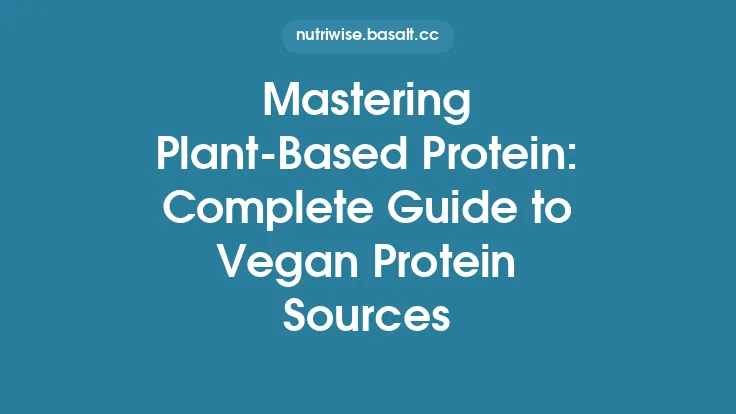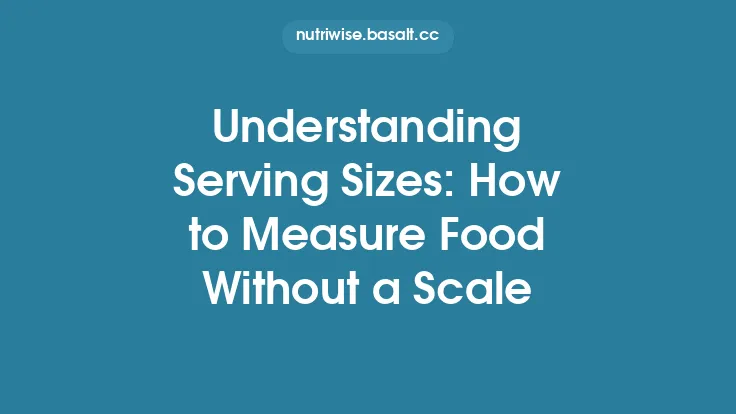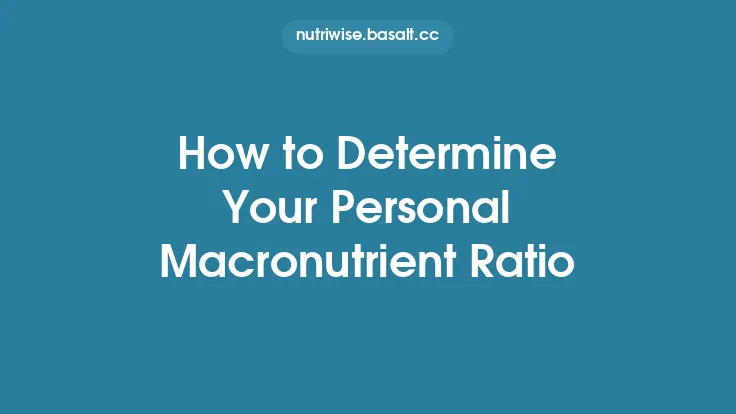A well‑balanced vegan meal isn’t about sacrificing flavor or satisfaction; it’s about thoughtfully combining whole‑food ingredients so that every bite delivers the nutrients your body needs. By applying a few core principles—understanding macronutrient distribution, securing key micronutrients, and using strategic food pairings—you can construct plates that are both nutritionally complete and delightfully varied. Below is a step‑by‑step guide to building such meals, complete with practical tools you can apply in the kitchen today.
Understanding the Foundations of a Balanced Vegan Plate
The simplest way to visualize a nutritionally sound vegan meal is the “plate method.” Imagine your dinner plate divided into three zones:
- Vegetables (≈½ of the plate) – Prioritize a rainbow of colors to capture a broad spectrum of phytonutrients, fiber, and antioxidants. Leafy greens, cruciferous veggies, root vegetables, and squashes each bring unique benefits.
- Complex Carbohydrates (≈¼ of the plate) – Whole grains, starchy vegetables, and tubers supply sustained energy, fiber, and B‑vitamins.
- Protein‑Rich Foods & Healthy Fats (≈¼ of the plate) – Legumes, tofu, tempeh, seitan, nuts, seeds, and avocado provide the protein and essential fatty acids needed for muscle maintenance, hormone production, and satiety.
By consistently filling each zone, you automatically hit most of the macro‑ and micronutrient targets without having to calculate every gram.
Macronutrient Considerations
| Nutrient | Primary Vegan Sources | Approx. Daily Goal (Adult) | Tips for Inclusion |
|---|---|---|---|
| Protein | Tofu, tempeh, edamame, lentils, chickpeas, peas, quinoa, nuts, seeds | 0.8–1.2 g per kg body weight (≈46 g for a 57 kg person) | Combine a protein source with each meal; a ½‑cup of cooked lentils (~9 g) plus ¼‑cup of quinoa (~4 g) already supplies ~13 g. |
| Carbohydrates | Brown rice, oats, barley, sweet potatoes, whole‑grain breads | 45–65 % of total calories | Choose whole‑grain varieties for added fiber and slower glucose release. |
| Fat | Olive oil, avocado, nuts, seeds (flax, chia, hemp), nut butters | 20–35 % of total calories, with emphasis on omega‑3 | Use a tablespoon of ground flaxseed or a handful of walnuts to meet omega‑3 needs. |
Balancing the Ratios
A practical starting point is a 40 % carbs / 30 % protein / 30 % fat split. Adjust based on activity level: athletes may push carbs higher, while those focusing on weight loss might increase protein and lower carbs slightly. Use a simple nutrition tracker (many free apps exist) for the first few weeks to see how your meals align with these ratios.
Ensuring Adequate Micronutrients
While a varied plant‑based diet covers most vitamins and minerals, a few nutrients require extra attention:
| Micronutrient | Why It Matters | Vegan Sources | Enhancement Strategies |
|---|---|---|---|
| Vitamin B12 | Nerve function, DNA synthesis | Fortified plant milks, nutritional yeast, B12 tablets | Choose at least one fortified product daily; a 250 µg tablet weekly is a reliable backup. |
| Iron | Oxygen transport, energy metabolism | Lentils, chickpeas, tofu, pumpkin seeds, dark leafy greens | Pair iron‑rich foods with vitamin C (e.g., bell peppers, citrus) to boost absorption. |
| Calcium | Bone health, muscle contraction | Fortified tofu, kale, bok choy, almonds, tahini | Aim for 2–3 servings of calcium‑rich foods; a cup of fortified soy milk provides ~300 mg. |
| Zinc | Immune function, wound healing | Beans, nuts, seeds, whole grains | Soak or sprout beans and grains to reduce phytate inhibition. |
| Omega‑3 (ALA, EPA/DHA) | Brain health, anti‑inflammatory | Flaxseed, chia, hemp seeds, walnuts, algae oil | Include 1–2 tbsp of ground flaxseed daily; consider an algae‑derived DHA supplement for EPA/DHA. |
| Iodine | Thyroid hormone production | Iodized salt, seaweed (moderate) | Use iodized salt in cooking; limit seaweed to a few grams per week to avoid excess iodine. |
Strategic Food Pairings for Optimal Absorption
- Iron + Vitamin C – A spinach salad topped with orange segments or a lentil stew served with a side of tomato salsa dramatically improves non‑heme iron uptake.
- Calcium + Vitamin D – Fortified plant milks often contain both; if you rely on unfortified sources, aim for modest sun exposure or a vegan D2/D3 supplement.
- Protein + Fiber – Combining beans with whole grains (e.g., black beans + brown rice) creates a complete amino acid profile while slowing digestion, keeping you fuller longer.
- Fat + Fat‑Soluble Vitamins – Drizzle olive oil over roasted vegetables or add avocado to a kale smoothie to enhance absorption of vitamins A, D, E, and K.
Portion Control and Energy Needs
Understanding your caloric baseline helps prevent both under‑ and over‑eating. A quick estimate:
- Basal Metabolic Rate (BMR) – Use the Mifflin‑St Jeor equation:
- For women: BMR = (10 × weight kg) + (6.25 × height cm) – (5 × age) – 161
- For men: BMR = (10 × weight kg) + (6.25 × height cm) – (5 × age) + 5
- Total Daily Energy Expenditure (TDEE) – Multiply BMR by an activity factor (1.2 sedentary, 1.55 moderate, 1.9 very active).
- Adjust for Goals – Subtract 250–500 kcal for weight loss, add 250–500 kcal for muscle gain.
Once you know your target calories, allocate them according to the macro ratios above. For example, a 2,000‑kcal diet with a 40/30/30 split translates to 800 kcal carbs (≈200 g), 600 kcal protein (≈150 g), and 600 kcal fat (≈67 g). Use measuring cups or a kitchen scale for the first few weeks to internalize portion sizes.
Meal Planning Frameworks
1. The “Build‑Your‑Bowl” Blueprint
- Base: ½ cup cooked whole grain (e.g., quinoa, farro) or starchy veg (e.g., roasted sweet potato).
- Protein: ½ cup cooked legumes, tofu, tempeh, or a handful of nuts/seeds.
- Veggies: 1–2 cups raw or lightly cooked vegetables.
- Healthy Fat: 1 tbsp olive oil, ¼ avocado, or a sprinkle of seeds.
- Flavor Boost: Fresh herbs, a squeeze of citrus, or a dash of low‑sodium soy sauce.
2. The “Batch‑Cook & Mix‑Match” System
- Step 1: Cook a large batch of a versatile grain (e.g., brown rice) and a batch of beans or lentils.
- Step 2: Roast a tray of mixed vegetables with herbs and a little oil.
- Step 3: Prepare a simple protein component (marinated tofu, tempeh, or a nut‑based patty) that can be reheated or served cold.
- Step 4: Store each component in separate containers; each day, assemble a bowl or plate using the proportions from the blueprint.
3. The “One‑Pot” Approach
- Combine grain, legumes, and vegetables in a single pot with broth and seasonings. As the mixture simmers, flavors meld, and you end up with a complete meal that requires minimal cleanup. This method works well for dishes like vegetable‑rich pilafs, hearty stews, or grain‑based casseroles.
Practical Tips for Everyday Meal Assembly
- Pre‑portion nuts and seeds into snack bags to avoid over‑consumption.
- Keep a “greens stash” in the fridge (pre‑washed spinach, arugula, or mixed salad greens) for quick salads.
- Use a high‑speed blender to turn frozen fruit, plant‑based milk, and a scoop of nut butter into a nutrient‑dense smoothie that can serve as a meal replacement when you’re short on time.
- Season in layers: start with aromatics (onion, garlic, ginger), add spices during cooking, and finish with fresh herbs or a splash of acid (vinegar, lemon) for brightness.
- Rotate staple proteins every week (e.g., week 1: tofu, week 2: tempeh, week 3: lentils) to keep the diet diverse and reduce the risk of nutrient gaps.
Adapting to Individual Goals and Preferences
| Goal | Adjustments |
|---|---|
| Weight Loss | Reduce the grain portion to ¼ cup, increase non‑starchy veg to 1½–2 cups, and add a modest amount of healthy fat (e.g., 1 tsp oil) to maintain satiety. |
| Muscle Gain | Boost protein to 1.6–2.2 g per kg body weight, incorporate protein‑dense foods like seitan or soy‑based isolates, and add a post‑workout shake with pea or rice protein. |
| Endurance Training | Emphasize carbohydrate density (larger grain or starchy veg portions) while still meeting protein needs; consider a carb‑rich snack (e.g., banana + almond butter) 30 min before activity. |
| Digestive Sensitivity | Choose low‑FODMAP legumes (e.g., canned lentils, mung beans), soak and rinse beans thoroughly, and incorporate fermented plant foods (outside the scope of ferment‑free condiments) for gut health. |
| Budget‑Conscious | Base meals around inexpensive staples: bulk brown rice, dried beans, seasonal frozen veg, and store‑brand tofu. Buying in bulk reduces per‑serving cost dramatically. |
Common Pitfalls and How to Avoid Them
- Relying on a Single Protein Source – This can lead to monotony and potential amino acid gaps. Rotate between soy, legumes, nuts, and whole grains.
- Neglecting Micronutrient Supplements – Vitamin B12 is non‑negotiable for vegans; iodine and DHA/EPA may also require supplementation depending on dietary patterns.
- Over‑Processing – Highly processed meat analogues can be high in sodium and additives. Use them sparingly and prioritize whole foods.
- Skipping Healthy Fats – Fat is essential for satiety and nutrient absorption. A drizzle of oil or a handful of seeds should be a regular component.
- Portion Blindness – Even plant‑based foods contain calories. Use visual cues (e.g., a fist for veg veggies, a cupped hand for grains) to keep portions in check.
Resources and Tools for Ongoing Success
- Nutrition Tracking Apps – Cronometer, MyFitnessPal, or the free “Open Food Facts” app can help you monitor macro and micronutrient intake.
- Meal‑Planning Templates – Printable weekly grids that prompt you to fill each plate zone ensure balanced variety.
- Online Databases – The USDA FoodData Central and the Vegan Society’s nutrient tables provide reliable composition data for less‑common foods.
- Community Support – Join local or virtual vegan cooking groups; sharing recipes and tips reinforces good habits and introduces new ingredients.
- Continuing Education – Short courses on plant‑based nutrition (e.g., from the T. Colin Campbell Center) keep you updated on emerging research without veering into the specialized topics listed in neighboring articles.
By applying these principles—visualizing a balanced plate, fine‑tuning macro ratios, safeguarding key micronutrients, and using systematic planning—you can craft vegan meals that are nutritionally complete, satisfying, and sustainable for the long term. The result is a diet that supports health goals without compromise, proving that plant‑based eating can be both wholesome and delicious.





